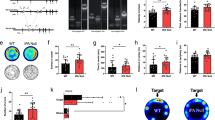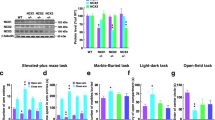Abstract
The hippocampus is essential for learning and memory, but it also plays an important role in regulating emotional behavior, as hippocampal excitability and plasticity affect anxiety and fear. Brain synaptic plasticity may be regulated by tissue inhibitor of matrix metalloproteinase 1 (TIMP1), a known protein inhibitor of extracellular matrix (ECM), and the expression of TIMP1 in the hippocampus can be induced by neuronal excitation and various stimuli. However, the involvement of Timp1 in fear learning, anxiety, and hippocampal synaptic function remains to be established. Our study of Timp1 function in vivo revealed that Timp1 knockout mice exhibit anxiety-like behavior but normal fear learning. Electrophysiological results suggested that Timp1 knockout mice showed hyperactivity in the ventral CA1 region, but the basic synaptic transmission and plasticity were normal in the Schaffer collateral pathway. Taken together, our results suggest that deletion of Timp1 in vivo leads to the occurrence of anxiety behaviors, but that Timp1 is not crucial for fear learning.






Similar content being viewed by others
References
Visse R, Nagase H. Matrix metalloproteinases and tissue inhibitors of metalloproteinases: Structure, function, and biochemistry. Circ Res 2003, 92: 827–839.
Nagase H, Visse R, Murphy G. Structure and function of matrix metalloproteinases and TIMPs. Cardiovasc Res 2006, 69: 562–573.
Ethell IM, Ethell DW. Matrix metalloproteinases in brain development and remodeling: Synaptic functions and targets. J Neurosci Res 2007, 85: 2813–2823.
Arpino V, Brock M, Gill SE. The role of TIMPs in regulation of extracellular matrix proteolysis. Matrix Biol 2015, 44–46: 247–254.
Ulrich R, Gerhauser I, Seeliger F, Baumgärtner W, Alldinger S. Matrix metalloproteinases and their inhibitors in the developing mouse brain and spinal cord: A reverse transcription quantitative polymerase chain reaction study. Dev Neurosci 2005, 27: 408–418.
Moore CS, Milner R, Nishiyama A, Frausto RF, Serwanski DR, Pagarigan RR. Astrocytic tissue inhibitor of metalloproteinase-1 (TIMP-1) promotes oligodendrocyte differentiation and enhances CNS myelination. J Neurosci 2011, 31: 6247–6254.
Moore CS, Crocker SJ. An alternate perspective on the roles of TIMPs and MMPs in pathology. Am J Pathol 2012, 180: 12–16.
Rivera S, García-González L, Khrestchatisky M, Baranger K. Metalloproteinases and their tissue inhibitors in Alzheimer’s disease and other neurodegenerative disorders. Cell Mol Life Sci 2019, 76: 3167–3191.
Crocker SJ, Pagenstecher A, Campbell IL. The TIMPs tango with MMPs and more in the central nervous system. J Neurosci Res 2004, 75: 1–11.
Knight BE, Kozlowski N, Havelin J, King T, Crocker SJ, Young EE, et al. TIMP-1 attenuates the development of inflammatory pain through MMP-dependent and receptor-mediated cell signaling mechanisms. Front Mol Neurosci 2019, 12: 220.
Jourquin J, Tremblay E, Bernard A, Charton G, Chaillan FA, Marchetti E, et al. Tissue inhibitor of metalloproteinases-1 (TIMP-1) modulates neuronal death, axonal plasticity, and learning and memory. Eur J Neurosci 2005, 22: 2569–2578.
Stetler-Stevenson WG. Tissue inhibitors of metalloproteinases in cell signaling: Metalloproteinase-independent biological activities. Sci Signal 2008, 1: re6.
Jung KK, Liu XW, Chirco R, Fridman R, Kim HR. Identification of CD63 as a tissue inhibitor of metalloproteinase-1 interacting cell surface protein. EMBO J 2006, 25: 3934–3942.
Tsagaraki I, Tsilibary EC, Tzinia AK. TIMP-1 interaction with αvβ3 integrin confers resistance to human osteosarcoma cell line MG-63 against TNF-α-induced apoptosis. Cell Tissue Res 2010, 342: 87–96.
Saura CA, Choi SY, Beglopoulos V, Malkani S, Zhang D, Shankaranarayana Rao BS, et al. Loss of presenilin function causes impairments of memory and synaptic plasticity followed by age-dependent neurodegeneration. Neuron 2004, 42: 23–36.
Felix-Ortiz AC, Beyeler A, Seo C, Leppla CA, Wildes CP, Tye KM. BLA to vHPC inputs modulate anxiety-related behaviors. Neuron 2013, 79: 658–664.
Kida H, Sakimoto Y, Mitsushima D. Slice patch clamp technique for analyzing learning-induced plasticity. JoVE 2017, 129: 55876. https://doi.org/10.3791/55876.
Zhang C, Atasoy D, Araç D, Yang X, Fucillo MV, Robison AJ, et al. Neurexins physically and functionally interact with GABA(A) receptors. Neuron 2010, 66: 403–416.
Walf AA, Frye CA. The use of the elevated plus maze as an assay of anxiety-related behavior in rodents. Nat Protoc 2007, 2: 322–328.
Villeda SA, Luo J, Mosher KI, Zou B, Britschgi M, Bieri G, et al. The ageing systemic milieu negatively regulates neurogenesis and cognitive function. Nature 2011, 477: 90–94.
Du F. Golgi-cox staining of neuronal dendrites and dendritic spines with FD rapid GolgiStain™ kit. Curr Protoc Neurosci 2019, 88: e69.
Tovote P, Fadok JP, Lüthi A. Neuronal circuits for fear and anxiety. Nat Rev Neurosci 2015, 16: 317–331.
Ghasemi M, Navidhamidi M, Rezaei F, Azizikia A, Mehranfard N. Anxiety and hippocampal neuronal activity: Relationship and potential mechanisms.Cogn Affect Behav Neurosci 2022, 22: 431–449.
Dong Z, Chen W, Chen C, Wang H, Cui W, Tan Z, et al. CUL3 deficiency causes social deficits and anxiety-like behaviors by impairing excitation-inhibition balance through the promotion of cap-dependent translation. Neuron 2020, 105: 475-490.e6.
Park HR, Cai M, Yang EJ. Neurogenic interventions for fear memory via modulation of the hippocampal function and neural circuits. Int J Mol Sci 2022, 23: 3582.
Jimenez JC, Su K, Goldberg AR, Luna VM, Biane JS, Ordek G, et al. Anxiety cells in a hippocampal-hypothalamic circuit. Neuron 2018, 97: 670-683.e6.
Zhang C, Wu B, Beglopoulos V, Wines-Samuelson M, Zhang D, Dragatsis I, et al. Presenilins are essential for regulating neurotransmitter release. Nature 2009, 460: 632–636.
Nicoll RA. A brief history of long-term potentiation. Neuron 2017, 93: 281–290.
He Y, Kulasiri D, Samarasinghe S. Modelling bidirectional modulations in synaptic plasticity: A biochemical pathway model to understand the emergence of long term potentiation (LTP) and long term depression (LTD). J Theor Biol 2016, 403: 159–177.
Jackson HW, Defamie V, Waterhouse P, Khokha R. TIMPs: Versatile extracellular regulators in cancer. Nat Rev Cancer 2017, 17: 38–53.
Eckfeld C, Häußler D, Schoeps B, Hermann CD, Krüger A. Functional disparities within the TIMP family in cancer: Hints from molecular divergence. Cancer Metastasis Rev 2019, 38: 469–481.
Grünwald B, Schoeps B, Krüger A. Recognizing the molecular multifunctionality and interactome of TIMP-1. Trends Cell Biol 2019, 29: 6–19.
Gomis-Rüth FX, Maskos K, Betz M, Bergner A, Huber R, Suzuki K, et al. Mechanism of inhibition of the human matrix metalloproteinase stromelysin-1 by TIMP-1. Nature 1997, 389: 77–81.
Cruz-Munoz W, Khokha R. The role of tissue inhibitors of metalloproteinases in tumorigenesis and metastasis. Crit Rev Clin Lab Sci 2008, 45: 291–338.
Cui H, Seubert B, Stahl E, Dietz H, Reuning U, Moreno-Leon L, et al. Tissue inhibitor of metalloproteinases-1 induces a pro-tumourigenic increase of miR-210 in lung adenocarcinoma cells and their exosomes. Oncogene 2015, 34: 3640–3650.
Grünwald B, Harant V, Schaten S, Frühschütz M, Spallek R, Höchst B, et al. Pancreatic premalignant lesions secrete tissue inhibitor of metalloproteinases-1, which activates hepatic stellate cells via CD63 signaling to create a premetastatic niche in the liver. Gastroenterology 2016, 151: 1011-1024.e7.
Nicaise AM, Johnson KM, Willis CM, Guzzo RM, Crocker SJ. TIMP-1 promotes oligodendrocyte differentiation through receptor-mediated signaling. Mol Neurobiol 2019, 56: 3380–3392.
Saha P, Sarkar S, Paidi RK, Biswas SC. TIMP-1: A key cytokine released from activated astrocytes protects neurons and ameliorates cognitive behaviours in a rodent model of Alzheimer’s disease. Brain Behav Immun 2020, 87: 804–819.
Tan HK, Heywood D, Ralph GS, Bienemann A, Baker AH, Uney JB. Tissue inhibitor of metalloproteinase 1 inhibits excitotoxic cell death in neurons. Mol Cell Neurosci 2003, 22: 98–106.
Agapova OA, Kaufman PL, Lucarelli MJ, Gabelt BT, Hernandez MR. Differential expression of matrix metalloproteinases in monkey eyes with experimental glaucoma or optic nerve transection. Brain Res 2003, 967: 132–143.
Okulski P, Jay TM, Jaworski J, Duniec K, Dzwonek J, Konopacki FA, et al. TIMP-1 abolishes MMP-9-dependent long-lasting long-term potentiation in the prefrontal cortex. Biol Psychiatry 2007, 62: 359–362.
Aoki T, Kataoka H, Moriwaki T, Nozaki K, Hashimoto N. Role of TIMP-1 and TIMP-2 in the progression of cerebral aneurysms. Stroke 2007, 38: 2337–2345.
Mercan Isik C, Uzun Cicek A, Ulger D, Bakir S. SIRT1, MMP-9 and TIMP-1 levels in children with specific learning disorder. J Psychiatr Res 2022, 152: 352–359.
Jaworski J, Kalita K, Knapska E. C-Fos and neuronal plasticity: The aftermath of Kaczmarek’s theory. Acta Neurobiol Exp (Wars) 2018, 78: 287–296.
Kaczmarek L. From c-Fos to MMP-9: In control of synaptic plasticity to produce healthy and diseased mind, a personal view. Postepy Biochem 2018, 64: 101–109.
Magnowska M, Gorkiewicz T, Suska A, Wawrzyniak M, Rutkowska-Wlodarczyk I, Kaczmarek L, et al. Transient ECM protease activity promotes synaptic plasticity. Sci Rep 2016, 6: 27757.
Young DA, Phillips BW, Lundy C, Nuttall RK, Hogan A, Schultz GA, et al. Identification of an initiator-like element essential for the expression of the tissue inhibitor of metalloproteinases-4 (Timp-4) gene. Biochem J 2002, 364: 89–99.
Baker AH, Edwards DR, Murphy G. Metalloproteinase inhibitors: Biological actions and therapeutic opportunities. J Cell Sci 2002, 115: 3719–3727.
Murphy G. Tissue inhibitors of metalloproteinases. Genome Biol 2011, 12: 233.
Cabral-Pacheco GA, Garza-Veloz I, Castruita-De la Rosa C, Ramirez-Acuña JM, Perez-Romero BA, Guerrero-Rodriguez JF, et al. The roles of matrix metalloproteinases and their inhibitors in human diseases. Int J Mol Sci 2020, 21: 9739.
Fanselow MS, Dong HW. Are the dorsal and ventral hippocampus functionally distinct structures? Neuron 2010, 65: 7–19.
Li Y, Xu J, Liu Y, Zhu J, Liu N, Zeng W, et al. A distinct entorhinal cortex to hippocampal CA1 direct circuit for olfactory associative learning. Nat Neurosci 2017, 20: 559–570.
Zhou X, Huang Z, Zhang J, Chen JL, Yao PW, Mai CL, et al. Chronic oral administration of magnesium-L-threonate prevents oxaliplatin-induced memory and emotional deficits by normalization of TNF-α/NF-κB signaling in rats. Neurosci Bull 2021, 37: 55–69.
Acknowledgements
This work was supported by grants from the Key-Area Research and Development Program of Guangdong Province (2019B030335001); the National Natural Science Foundation of China (81925011, 92149304, and 32200636); the R&D Program of Beijing Municipal Education Commission (KM202310025028) and the High-Level Teachers project (CIT&TCD20190334); and the Youth Beijing Scholars Program (015).
Author information
Authors and Affiliations
Corresponding authors
Ethics declarations
Conflict of interest
The authors claim that there are no conflicts of interest.
Supplementary Information
Below is the link to the electronic supplementary material.
Rights and permissions
Springer Nature or its licensor (e.g. a society or other partner) holds exclusive rights to this article under a publishing agreement with the author(s) or other rightsholder(s); author self-archiving of the accepted manuscript version of this article is solely governed by the terms of such publishing agreement and applicable law.
About this article
Cite this article
Wang, X., Zheng, W., Zhu, Z. et al. Timp1 Deletion Induces Anxiety-like Behavior in Mice. Neurosci. Bull. (2023). https://doi.org/10.1007/s12264-023-01163-1
Received:
Accepted:
Published:
DOI: https://doi.org/10.1007/s12264-023-01163-1




